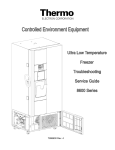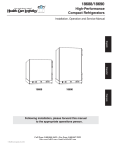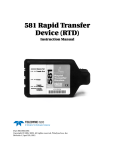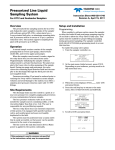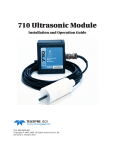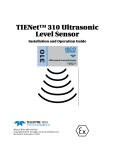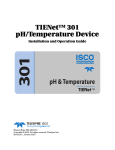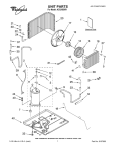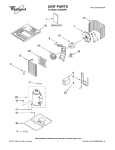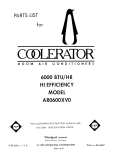Download 5800 Refrigerated Sampler Temperature Sensor Cable
Transcript
5800 Temperature Sensor Cable Assembly Instruction Sheet #60-4702-070 Revision D, January 14, 2013 Removal and Replacement Overview Required Parts and Tools The 5800 has two refrigeration temperature sensors, one attached to the evaporator coil to measure the evaporator temperature, and the other mounted on the refrigerator’s rear wall to measure the refrigeration air temperature. The two refrigeration temperature sensors are part of the temperature sensor cable assembly kit. Note that this instruction sheet is for both the 5800 sampler and the older model 4700 sampler. Some information applies solely to the 4700 sampler, and will be clearly marked as such. Before attempting to remove and replace a module, observe the following precautions: Replacement cable assembly kit 69-5804-054 #2 Phillips screwdriver #3 Phillips screwdriver Wire cutters ● ● ● ● 15 /16" open wrench Clear silicone sealant Cable tie 489-0110-00 (for best results, soak in water for one hour prior to use) ● ● ● Removal 1. Unplug the line cord to remove AC power. 2. Remove the cover brace, back cover, and insulation panel (Figure 1). WARNING Removing a module exposes you to electrical and mechanical hazards. Always disconnect the AC power cord before attempting to remove any module. Only trained service personnel may remove or replace these modules. Refrigeration module Insulation panel CAUTION Removing the sealed modules will expose the internal components. Wet or corrosive atmospheres may attack the exposed refrigerator components. Always service modules in a dry, corrosion-free environment. Back Cover Cover brace CAUTION Modules contain circuit boards and sensitive electronics that can be damaged by a discharge of static electricity. Avoid touching the internal components. Only handle the module by the edges or exterior surfaces. Figure 1: Remove back cover and insulation CAUTION 3. Cut the cable tie from the power cord that runs through the refrigeration assembly (Figure 2). Electrical connectors and wires can be damaged if improperly handled. Electrical connectors must only be handled by the connector body. Never grasp the wires or use tools to disconnect a connector. Never allow a module to hang by its wiring. Cut cable tie CAUTION Earth ground bonding conductor. Do not remove or disconnect. If this conductor must be disconnected to remove a module, it must be reconnected when installing the replacement module. Figure 2: Cut cable tie from line cord (Full line cord length not depicted) 1 Instruction Sheet #60-4702-070 Revision D, January 14, 2013 4. Remove the refrigeration module mounting screws (Figure 3). Note that the refrigeration module has an adhesive strip just above the rear coils. The bottom center screw may be slightly hidden by this strip. 5. Carefully pull the module out and rotate clockwise to expose the wiring connectors. b. Slide the bushing sideways away from the refrigeration module until it is free (Figure 5). Use care to avoid bending the refrigeration tubing. CAUTION Keep the module as close to the refrigerator body as possible to avoid pulling the wiring taut and damaging the connectors. Figure 5: Remove power cord c. Pull the power cord through the refrigeration module. Turn module out and left 7. Open the flip cover of the sampler and remove the control panel mounting screws. Adhesive strip Figure 3: Remove the refrigeration module mounting screws Figure 6: Control panel module removal 6. Remove the power cord, following substeps a, b, and c. a. 230 VAC Models Only – Remove the AC Plug adapter from the end of the power cord by first cutting away the plastic heat shrink tubing. Then pull the adapter off, leaving just the North American 115 VAC plug (Figure 4). 8. Lift the control panel to expose the wiring connectors, taking care not to put strain on the wires. Removing the Cable Assembly 1. Disconnect the temperature sensor cable from connector P3 (P5 for older model 4700 samplers) on the control board and set the control panel back in place. CAUTION When disconnecting a cable connector, always grasp the connector itself and not the wires. CAUTION Figure 4: Remove adapter from power cord (230 VAC models Only) When connecting the temperature sensor cable to P3 on the control board, ensure that it is not reversed. The slots on the cable connector must be facing inward. 2 Instruction Sheet #60-4702-070 Revision D, January 14, 2013 2. Remove the large ferrite bead from the connector end of the cable (it snaps apart). Retain the ferrite bead for installation on the replacement cable assembly. Ferrite Bead Cable Connector Figure 7: Ferrite bead on cable connector end (May not be present on older 4700s) 3. The evaporator sensor is mounted on the sixth coil up on the evaporator (see Figure 8). Note that some older 4700s have a metal sensor, while current models have a black rubber molded housing. Cut the ties holding the evaporator sensor in place and move it out of the frame. Close-up of sensor in holder Figure 9: Removing rear wall sensor (power supply plate not shown) 5. The wiring assembly enters the rear of the refrigeration cabinet just above the upper left corner of the fan (Figure 10). Unscrew the black cord-grip fitting from the bulkhead fitting in the refrigerator’s rear wall. Cord-grip fitting Older (4700 only) Bulkhead fitting Current (4700 & 5800) Figure 8: Removing evaporator temp sensor Cut cable ties Temperature sensor cable 4. Slide the rear wall sensor out of its plastic holder (located behind the power supply plate, Figure 9 below). Figure 10: Temperature sensor wiring entry at rear of cabinet 3 Instruction Sheet #60-4702-070 Revision D, January 14, 2013 10. Gently press the metal sensor into the plastic holder behind the power supply plate until it snaps into place. 11. Replace the refrigeration module, insulation, rear panel, and cover brace. 6. Gently loosen the bulkhead fitting with the 15/16" open-end wrench and unscrew it from the refrigerator cabinet. Pull the cable connector out through the threaded opening. Temp sensor cable connector Cord grip fitting Note 5800 rear wall When reinstalling all self-tapping screws, avoid destroying the plastic threads. First, seat each screw in its hole and, without pressing down, rotate the screw counter-clockwise until it falls into its thread groove with a "click." Then tighten the screw. Bulkhead fitting Figure 11: Temperature sensor cable and bulkhead connector 12. Ensure that the control wiring runs through the notches in the plastic refrigerator body. The refrigeration module and rear compartment of the cabinet have adhesive strips and Permagum2 (caulking cord sealant) protecting the components (Figures 12 and 13). Ensure that all Installing the New Cable Assembly 1. Carefully feed the connector end of the new cable through the threaded opening from the rear of the cabinet. 2. Apply a coating of the clear silicone sealant (such as Dow Corning®1 737 RTV) to the threads of the cable’s bulkhead fitting. 3. Screw the bulkhead fitting into the cabinet wall until the threads bottom out. Smooth the excess silicon sealant around its base to seal the joint. 4. Tighten the black plastic cord-grip fitting over the bulkhead fitting. 5. Clean the control panel’s mounting surface on the face of the refrigerated compartment. This will help ensure that the gasket will seal the enclosure. adhesive strips and Permagum are still in place before reassembly. CAUTION The adhesive strips and Permagum are required to prevent air flow between the condenser coil and the evaporator plate. Without this protection, water condensation on the coil will cause ice build-up, resulting in poor refrigerator performance. Note Two thick, black cables connect the power supply with the module and compressor (see Figure 12). Ensure that these cables are side by side and not crossed during reassembly. 6. Install the ferrite bead 3/4" from the cable connector. Wrap the cable one complete turn around the bead and snap it closed (Figure 7). 7. Attach the new cable to P3 on the control board (or P5 for older 4700s). 8. Align the control panel over the mounting holes and secure it with the mounting screws. Torque screws 1.8 to 2.0 Nm (16 to 18 in/lbs). 9. Using the two plastic cable ties, mount the black sensor on the sixth coil of the evaporator as shown in Figure 8. To operate correctly the sensor must be mounted in the exact position shown. Permagum sealant Power supply cables Note Adhesive strips Figure 12: Rear view with module removed (Adhesive strips, Permagum sealant, and power cables) When installing the black molded sensor, be careful not to overtighten the cable tie on the sensor body, as internal damage could occur. The sensor should be snug against the coil, but the rubber housing should not be visibly dented. 1. Dow Corning® is a registered trademark of Dow Corning Corporation. 2. Permagum is a registered trademark of the Presstite Engineering Company. 4 Instruction Sheet #60-4702-070 Revision D, January 14, 2013 Adhesive strip Center screw Permagum sealant Figure 13: Rear view of refrigeration module (Adhesive strip and Permagum sealant) 13. Hold the line cord taut to remove any slack, and attach a cable tie 489-0110-00 (Figure 14). CAUTION When installing/replacing the refrigeration unit, the line cord MUST be properly secured. This is to ensure that the cord cannot be pushed into the enclosure and catch in the fan. Cable Tie Bushing Figure 14: Secure AC Power Cord (Full length of line cord not depicted) 14. Restore AC power. After 30 minutes, perform the refrigerator temperature diagnostic test (see your user manual). As the refrigerator cycles off and on, the reported temperature will rise above and below the set temperature. However, the average reported value should be the same as the set temperature. Teledyne Isco P.O. Box 82531, Lincoln, Nebraska, 68501 USA Toll-free: (866) 298-6174 • Phone: (402) 464-0231 • Fax: (402) 465-3001 E-mail: [email protected] Teledyne Isco is continually improving its products and reserves the right to change product specifications, replacement parts, schematics, and instructions without notice.





